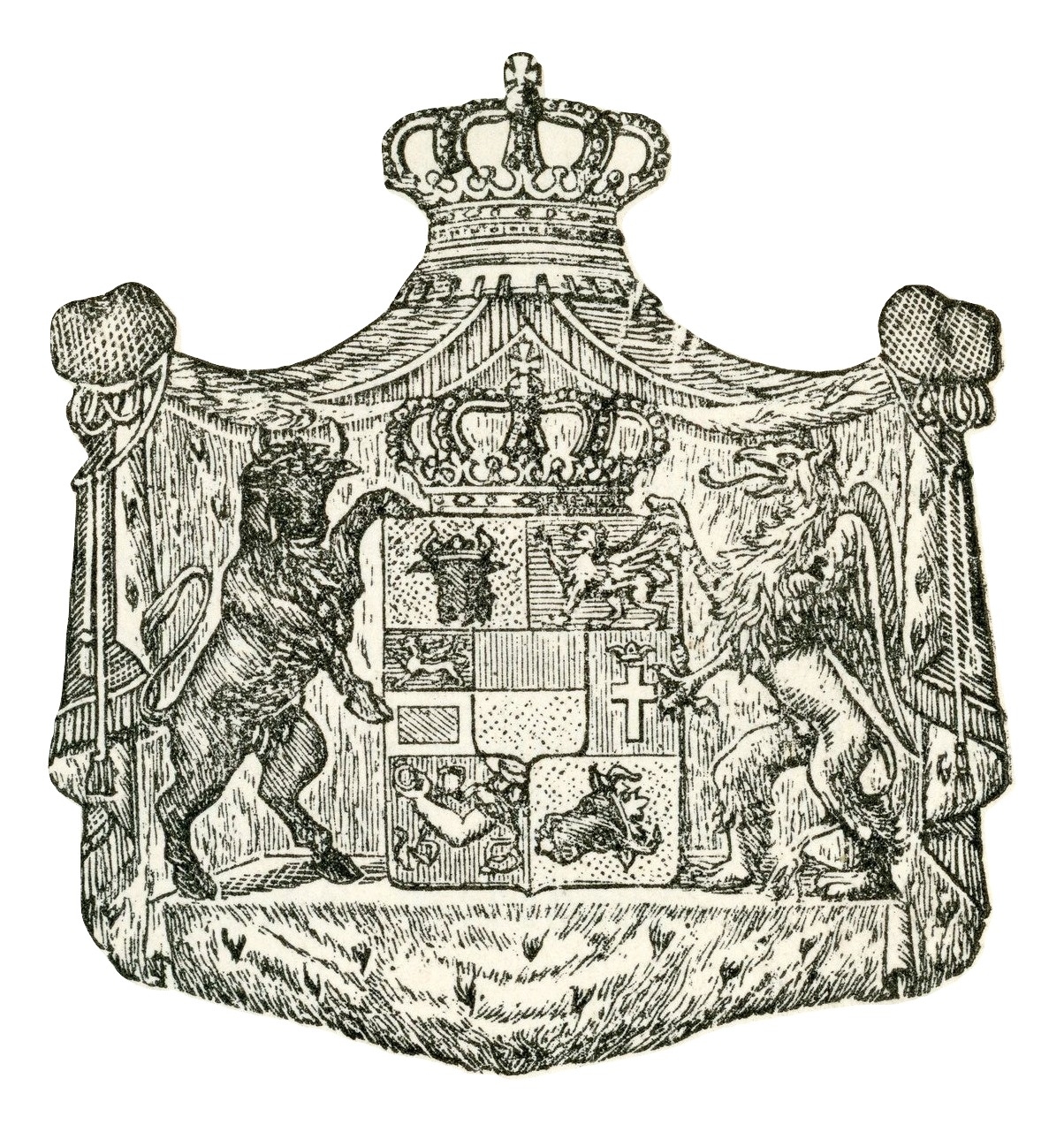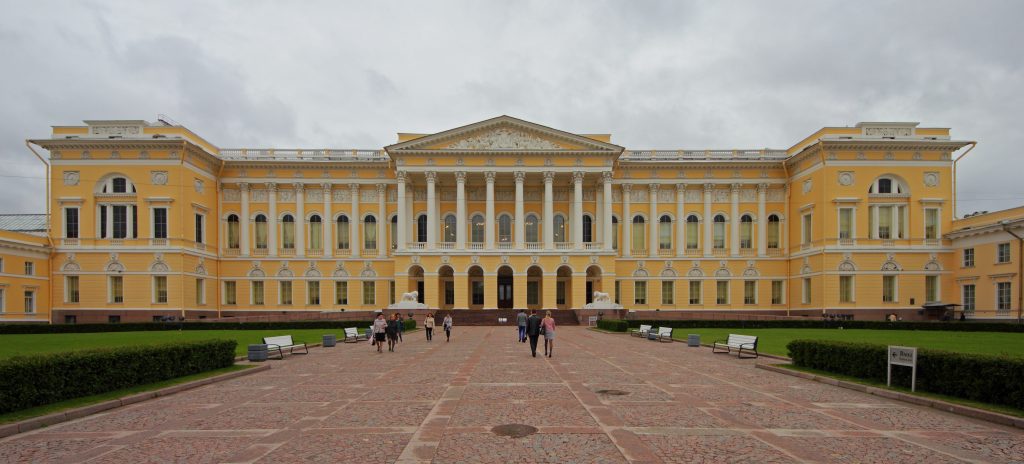Mikhailovsky Palace
The Mikhailovsky Palace is the former St Petersburg residence of the Russian branch of the grand ducal family. Following the birth of Grand Duke Mikhail Pavlovich of Russia in 1798 his father Emperor Pavel set aside funds for the construction of a palace for the young grand duke. It would be over 20 years before construction would begin by which time Mikhail was 21 and his brother Emperor Aleksandr I had succeeded their father on the throne. The palace was the work of the Italian architect Carlo Rossi and was constructed in the neoclassical style. From the beginning of construction in 1819 it took just six years to complete.
Following Grand Duke Mikhail’s death in 1849 the palace became the property of his widow Grand Duchess Elena Pavlovna (nee Princess Charlotte of Württemberg). Its connection to the House of Mecklenburg-Strelitz began in 1851 when the couple’s last surviving daughter the Grand Duchess Ekaterina Mikhailovna married Duke Georg, younger son of Grand Duke Georg. Grand Duchess Ekaterina inherited the Mikhailovsky Palace in 1873 following the death of her mother. Her elder son Duke Georg Alexander was married at the palaces chapel on 14 February 1890 to Russian noblewoman Natalia Vanljarskaya. Georg Alexander and his siblings, Helene and Carl Michael inherited the palace following the death of their mother in 1894.
The Mikhailovsky Palace was sold to Emperor Nikolai II in 1895 for 4 Million Silver Roubles and was subsequently turned into the Russian State Museum.
46 Fontanka (Carlow mansion)
Located at number 46 along the Fontanka river embankment in St Petersburg is the former city residence of Duke Georg Alexander and his family. The two story mansion was purchased from the Zinoviev family in 1895 for 600,000 Rubles, with Duke Georg Alexander using his share of the proceeds from the sale of the Mikhailovsky Palace. The mansion dates from the 1740s and was originally made of timber before being rebuilt using stone in the 1760s. During the 1830s impressive gates, the design of architect Vincent Beretti, were erected at the main entrance of the estate on the Fontanka side. In the early 1840s the mansions owner Nikolai Zinoviev recruited the German architect Wilhelm Langwagen to completely reconstruct and enlarge the house. Duke Georg Alexander made alterations to the interior and façade, commissioning his architect V.P. Statsenko to carry out the work which included adding the Mecklenburg-Strelitz family coat of arms to the mansion’s pediment.
Under the grand ducal family’s ownership the Fontanka mansion would become known as the ‘Carlow mansion’ after Countess Natalia of Carlow, the non dynastic wife of Duke Georg Alexander. In addition to family of Duke Georg Alexander his brother Duke Carl Michael also lived in the mansion having eight rooms on the first floor made available to him. Under the ownership of the music loving duke, Russian musicians, including the duke’s own string quartet, were regularly invited to perform private concerts at the mansion. After the death of Duke Georg Alexander in 1909 his widow and family continued to maintain the residence. During the First World War the couples eldest daughter Katharina opened a hospital for recuperating Russian officers in the main rooms of the mansion. After the family’s departure from St Petersburg in 1917 following the fall of the Russian monarchy and subsequent Bolshevik revolution, the mansion would become part of the Museum of the City. It retained this status until 1929.
With end the Soviet Union in 1991 the mansion was taken over the following year by the Mayakovsky Library’s Department of Foreign Language Literature. Since October 1994, The Prince George Galitzine Memorial Library has been located in one of the rooms of the mansion. The late Prince George Galitzine was the grandson of Duke Georg Alexander and his wife Countess Natalia of Carlow.
Oranienbaum
The Oranienbaum palace complex is the former country seat of the Russian branch of the grand ducal family. In 1707, four years after he had founded the city of St Petersburg, the Russian Emperor Pyotr I “the Great” granted land located west of St Petersburg on the Gulf of Finland to his trusted advisor Prince Aleksandr Danilovich Menshikov, the first Governor General of St Petersburg. Prince Menshikov set about transforming his land into a grand residence which he gave the name Oranienbaum which is German for “wild orange trees”.
The baroque grand palace was built between 1710 and 1725 by architects Giovanni Maria Fontana and after 1713 Johann Gottfried Schadel. After Prince Menshikov’s 1727 arrest and exile from Russia his Oranienbaum estate was confiscated by the state and turned over to the Ministry of Works who converted it into a Naval Hospital.
In 1743 the Empress Elizaveta granted Oranienbaum to her nephew and heir the future Emperor Pyotr III who commissioned architect Francesco Bartolomeo Rastrelli to renovate the interior of the palace. In 1758 Pytor III commissioned Italian architect Antonio Rinaldi to build a small fortress for himself in the grounds of the estate which included a small two-storey mansion which is known as the Pytor III Palace. The majority of the fortress including the barracks, officers’ mess, arsenal, parade ground and Lutheran church were removed by Pytor’s son Emperor Pavel I in 1788, today only the Pytor III Palace and gate tower remain. In 1762 Rinaldi was also commissioned to work on the grand palace adding a granite staircase and semi-circular balcony to the northern terrace.
Following Pytor III’s deposition in 1762, Antonio Rinaldi was once again commissioned to work at Oranienbaum, this time by Pytor’s wife and successor Empress Ekaterina II “the Great”, who had a private residence built for herself in the grounds of the estate. The building which is a single-storey high with the exception of the central pavilion was completed in 1768 and named the Chinese Palace.
After being used as a Naval Cadet College for a period, in 1796 Oranienbaum passed to the future Emperor Aleksander I. In 1831 his brother Grand Duke Mikhail Pavlovich and his wife Grand Duchess Elena Pavlovna received ownership of the estate. It’s through their daughter Grand Duchess Ekaterina Mikhailovna that Oranienbaum’s connection with the grand ducal house began. Following her death in 1894 the estate was inherited by her three children Duchess Helene, Duke Georg Alexander and Duke Carl Michael. With the estate possessing a number of buildings the three children decided to make use of this and assign each of them a specific places of residence. As such the Grand Palace became the country residence of Duke Georg Alexander and Duke Carl Michael while their sister Duchess Helene received the Chinese Palace.
Oranienbaum provided an idyllic setting for the children of Duke Georg Alexander. During the summer months the family could go swimming and rowing on the estate, take carriage rides around the park and picnics in nearby villages, there was also a pony stables to enable the children to learn to ride. The estate also had its own tennis court. The winter provided the chance for ice skating and skiing, while in the autumn the palace was used to host fancy-dress parties and children’s balls. Duke Georg Alexander and his youngest daughter Countess Natalia of Carlow are both buried at Oranienbaum.
As with the rest of the grand ducal family’s Russian assets following the fall of the Russian monarchy in 1917 and subsequent Bolshevik revolution the Oranienbaum estate was confiscated by the state. The town adjacent to the estate shared the Oranienbaum name until 1948 when it was renamed Lomonosov after the Russian scientist Mikhail Lomonosov. In 1997 Duke Borwin and his family made the first of a number of visits to Russia and their family’s former residences there. The duke’s most recent visit was in 2012.



